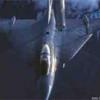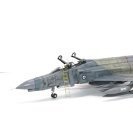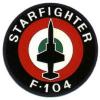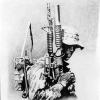Search the Community
Showing results for tags 'NASA'.
-
Evening everyone, I came home from work tonight to find that my wife has surprised me with a very small present of something that I have wanted for a while. She knew I wanted a space shuttle in launch configuration, but that I didn't have room for a much larger kit. She found an Academy kit in 1:288 scale in our local Hobbycraft shop and went to get it for me. It's a very basic kit but does have decal options for all of the space shuttle orbiters (Enterprise, Columbia, Atlantis, Challenger, Discovery and Endeavour. I always wished that after the Challenger accident, NASA had refitted the Enterprise into a spaceworthy shuttle as they did in Dale Brown's amazing novel Silver Tower (which is one of my favourite books). I am therefore considering building this one as the Enterprise, but will be doing it with an orange external fuel tank rather than the white that it specifies the tank should be painted in the instructions. I just wish it was easy to find out what shade of orange to paint it. The painting instructions from Revell's instructions call for the tank to be painted in a Wood brown colour mixed with 10% white. Here are photos of the box art and sprues. I will be making a start on this one at the weekend and will probably have it finished quite quickly as I'm off work for a week after tomorrow. Look for updates as I start the building and painting process, All the best, Rick
-
Happy Anniversary Skylab 50 years ago today Skylab, America's first space station, was launched. I'm not going to discuss Skylab's history in detail right now, there will time for that later but suffice to say that this programme set numerous records for human occupancy in outer space, gathered an enormous amount of scientific data regarding both planet Earth and the Sun and was involved in a couple of episodes of aerospace drama that sometimes tested NASA’s ingenuity and determination to the limit. It was also - in its own way - rather beautiful. Skylab is well remembered here in Western Australia because on the evening of 11 July 1979 as it disintegrated in the Earth's upper atmosphere it scatteried debris over a large elliptical area to the North-East of the small W.A. town of Esperance. No one was hurt and no damage was caused. For a brief period the eyes of the world were on Western Australia and a flurry of activity followed as numerous folks went out in search of souvenirs. Surprisingly I have only ever seen one model of Skylab in W.A. It was given to the Shire of Esperance by NASA and is on display, along with various pieces of debris, in the Esperance community museum. I'm going to have a crack at building my own model and hopefully - despite this early start - will be able to join into @bianfuxia's upcoming 'Beyond the Karman Line' group build. Here are my main references. And the principal drawings that I will be working from. It turns out that 70mm PVC piping from Bunnings is freakishly - exactly - the correct diameter for the main orbital workshop. and that 25mm electrical conduit is also - exactly - the correct diameter for the multiple docking adaptor module. So, earlier tonight, on the evening of the 50th anniversary of the launch, I made the first cut in this project. Followed by marking up and cutting out two bulkheads from MDF. That sit snugly in the workshop like so... and then have a central hole cut in them so that the central 'axis' of the model (the aforementioned conduit) can slip through the centre of the orbital workshop . Leaving this... Which is a pretty good start I think. Unfortunately I now have four projects on the go, which is not ideal. Top priority stays with finishing the PZH-2000. I'm giving myself plenty of time for this one - about 6 years in fact - as I want it finished in time for the re-entry anniversary! 🙂 Best Regards, Bandsaw Steve
- 50 replies
-
- 23
-

-
- NASA
- Scratchbuild
-
(and 1 more)
Tagged with:
-
Skylab Hi Karman line team. As promised on the chat I'm switching my Skylab project, currently on the Science Fiction and Realspace forum, into this groupbuild. I'm well below the 25% threshold at least in terms of time to finish this project and @bianfuxia (who I understand is the boss around here) seems to think it's OK for me to pop across here for a bit, so here I am. This is my first group-build BTW so it's all very exciting! Anyhow, here's a link to the story so far... I have not achieved a huge amount just yet but that's mostly because my spare time was being sunk into finishing my PzH 2000 so hopefully being in this group might cause me to focus on Skylab a bit more. Here's something like what I want to make...(mine won’t have the big rocket-bit sticking out the back of the workshop because it was not there on the final deployed version). and here's where I'm up to. Doesn't look like much yet but hopefully it's on the right track. I'm very much looking forward to being a space groupie! Hopefully I'll make some progress over the next few months. See you all soon, Bandsaw Steve
- 111 replies
-
- 22
-

-
- Scratchbuild
- NASA
-
(and 1 more)
Tagged with:
-
DC-8-72 N817 belonging to the Neil A. Armstrong Flight Research Center, Edwards AFB. She actually operates out of Palmdale airport. Visiting Wright-Patterson AFB 31 July 2023. Thanks for looking, Sven Old Viper Tester
-
Hey All, It's me RichO, I'm getting down here from the sci/fi, real space section, Apollo Crawler at 1/72. This is the first posting of a diorama build I have been considering for some time now. I have decided to start this thread to help fill the void of the crawler build, which is coming to a close. And to get me thinking in the general direction of this build. This is a build that I have been thinking about for a couple of years now. All during the crawler build I have been gathering kits and materials for this dio. At this point I feel I should start this thread with some general info and ideas of what I have in mind. This is a diorama dedicated to the memory of Col. Gordon Cooper. The last American to orbit the earth solo. Gordon Cooper saw some funny things while in orbit that changed his life. I admire him for speaking the truth. You can look it all up if your interested. This is what I hope this build will look like at the end of the process, that will take,... who knows how long. Launch Complex 14 I'll have to crop the tarmac a bit to get the scene into the shape and space that I have for this build. Thanks to Mike and Dave, I have a scene that is all dio and just the rocket will be built in the model section. like most military dio's I have seen,... I will have my background structures, ( the launch tower and the service tower), I will have my ruined street (the tarmac and infield surfaces), I will have all the litter and debris strewn about ( the signs, and lights, and post, and vehicles...) the vehicle will come last...the Mercury Atlas 9-Faith 7. To be built in the space section. These are the kits that I have to work with and to kit bash if I need to...All the kits are Revell, and some are older than my wife...all are originals... I have decided to build this dio onto a pedestal, as apposed to a thinner frame. This dio will be vertical and should have a tallish pedestal for its base. Much like the statue of liberty has a tallish pedestal for its vertical composition. The first step was to figure out some material that would be strong enough to support this whole endeavor, and I wanted something that had an industrial sort of look and feel to it, and something that would not appear out of place in or around the tarmac or the launch area. I needed it to blend in. So as most scratch builders do, I always keep an eye out for stuff and junk to use. one day while I was at the market, I got one of "Those" carts... the floppy wheels, it wont turn, a little bent. And while I was looking at this thing I noticed the texture of the plastic that the cart was made out of. Where I live, when the carts go bad, they go to cart heaven, out behind the building... So I went and pinched one while no one was looking and cut it apart to get the sides of the pedestal material... Then I figured out the general shape of the layout. This is what I came up with... The circle is the rocket on the launch pad, and the masking tape is where vehicles will be placed. You can see the related layout of the rest of the structures. The idea is to get the tarmac up, off the table a couple of inches to help reinforce the vertical. I also have an idea of a sort of 3d effect with some sort of structure under the tarmac base on the inside of the pedestal. not sure just yet but I'll figure something. So that's where I'm at with the base at the moment. I have the general layout, I have the dimensions 16 inches wide x 30 inches long x 4 inches tall, and I have the material to start the build. Be back later when I figure out how to join the corners of the pedestal and what to put inside the base. Thanks All...later
- 322 replies
-
- 10
-

-
Hi all and just finished this old Japanese classic for...well, for a Japanese Classic kits GB here!. According to Scalemates, this was first issued in 1967 but I went for the slightly later 1973 boxing. The build thread is here but to recap: Kit: Hasegawa/Minicraft T-38A Talon (F-5B) JS-018 all the way to Ireland from the 2022 IPMS Nationals in Omaha Nebraska (thanks Pat) Build: Scratchbuilt cockpit of sorts instead of the 1970s pegs. One-piece canopy cut into four. Paint: Mr Hobby and Tamiya. Pencil for panel lines. Klear. Decals: VMDecals for NASA T-38 of Dryden Flight Research Center (thank you again Steve R ) plus stencils from the spares. Not an accurate T-38 at all really but had great fun trying to improve it and really love that I've built a NASA Talon. Now to build a 1/72 Shuttle so it can act as chase! 😜 Thanks for looking, take care and happy modelling. All the best, Dermot Hasegawa_T-38_Talon_NASA_done (7) by Dermot Moriarty, on Flickr Hasegawa_T-38_Talon_NASA_done (2) by Dermot Moriarty, on Flickr Hasegawa_T-38_Talon_NASA_done (5) by Dermot Moriarty, on Flickr Hasegawa_T-38_Talon_NASA_done (4) by Dermot Moriarty, on Flickr Hasegawa_T-38_Talon_NASA_done (6) by Dermot Moriarty, on Flickr Hasegawa_T-38_Talon_NASA_done (9) by Dermot Moriarty, on Flickr Hasegawa_T-38_Talon_NASA_done (8) by Dermot Moriarty, on Flickr
- 16 replies
-
- 46
-

-

-

Boeing 747SP - NASA/DLR SOFIA - Welsh Models 1/144
zebra posted a topic in Anything But Injection GB
I've got a few entries in this GB in mind and haven't entirely decided on the others yet, but the first one is definitely going to be the Welsh Models 1/144 vacform Boeing 747SP converted to the NASA/DLR telescope-carrying aircraft N747NA. I'll post a pic of the kit later, but here's the 1/1 version in flight: I've been doing some CAD work on the telescope and fairing: and done a test print of the parts: This was my first attempt at a print with my Photon Mono printer. Some of the parts came out fine, some of them will need to be printed again with the supports in a different place or in a different orientation, and a few of them (particularly the rear parts of the fairings) were too thin and didn't come out well, so will need to be redesigned (but I have a plan for that). Also needs to be test-fitted to the fuselage so I might need to tweak the design for a better fit. It's going to be displayed in flight (probably) as the door to the telescope cavity wouldn't usually be open on the ground. I'm currently on the lookout for a suitable base for a stand. V1 decals produces some good-looking laser-printed decals for N747NA - I've got 2 copies just in case (if you want two copies of a sheet in case you need spares they sell the second one half price). Can't wait to get going. Might start cutting out the vacform parts a bit early - it'll be well below 25% when we start. thanks for looking Julian- 19 replies
-
- 20
-

-
- 3d printing
- Welsh Models 1/144th vacform
-
(and 1 more)
Tagged with:
-
I spent ages mulling over which of the Japanese kits in the stash to build and completely overlooked this one: The Otaki 1/144 Aero Spacelines Super Guppy Turbine from 1974, later reboxed by Revell, which is the kit I'll be using. The kit decals might well turn out to be past it, since the kit was last issued 37 years ago, but I've got a set of decals from Vintage Flyer for NASA's SGT, which is the last one flying. This is what I hope it'll end up looking like: This was the last one built, first built as number 4 for Airbus. Back in the 80s and 90s the Airbus Guppies were regular visitors to Manchester and really stood out amongst the airliners of the day - this is my photo of the same airframe at Manchester, probably in the early 90s. I've got four builds going on in other GBs at the moment so will have to leave this as a placeholder for now while I get at least one or two of them done and some space cleared on the bench. cheers Julian
- 12 replies
-
- 17
-

-
- 1/144 Super Guppy
- Revell
-
(and 1 more)
Tagged with:
-
Here's my Trumpeter 1/72 F-106B built as NASA 616, which was modified in the late '60s with a General Electric J85 engine under each wing and a variety of different intake and nozzle configurations, to test designs for the supersonic transport programme. The J85s were 3D-printed, the only other modification required was to split the flaps - the one-piece flaps were split into three with the section above and behind the J85s fixed in place. Decals were from the kit sheet, an Xtradecal sheet, a Cutting Edge sheet of NASA logos, plus a couple of home-printed decals. I built this in the prototypes, racers, research, record breakers and special schemes GB - build thread is here. thanks for looking Julian
- 17 replies
-
- 70
-

-
- Trumpeter
- 1/72 F-106B
-
(and 1 more)
Tagged with:
-
Hi all, Have decided to scratch that itch and am in with a two-seat Eagle in a NASA scheme. More pics once I find the kit in the attic and the decals arrive in the post 😎 Good luck with your builds! Cheers, Der
- 17 replies
-
- 2
-

-
- Two-Seater
- Test
-
(and 1 more)
Tagged with:
-
https://flic.kr/p/2nmX29Fhttps://flic.kr/p/2nmQtmNhttps://flic.kr/p/2nmVKGThttps://flic.kr/p/2nmQtomhttps://flic.kr/p/2nmYjoQ this is my first post to bm so if anything is not working please let me know, and any ideas to improve my models are welcome
- 13 replies
-
- 11
-

-
Good night to all, I'm glad to present my last work, a T-38 A Talon from Wolpack. I've built the kit OOB except for some scratchbuilt addictions in the cockpit (i.e. the separation glass of the central frame) and in the wheels/airbrakes bay. I also added the positive rivets from Archer on the exhausts zone. Pilot's name decal on the rear canopy taken from the Fundekals sheet. Hope you'll enjoy... take care and stay safe in this difficult moments. Cheers frome Rome. Valerio. Talon END 3 by Valerio, su Flickr Talon END 4 by Valerio, su Flickr Talon END 5 by Valerio, su Flickr Talon END 6 by Valerio, su Flickr Talon END 7 by Valerio, su Flickr Talon END 8 by Valerio, su Flickr Talon END 9 by Valerio, su Flickr Talon END 10 by Valerio, su Flickr Talon END 11 by Valerio, su Flickr Talon END 12 by Valerio, su Flickr Talon END 13 by Valerio, su Flickr Talon END 14 by Valerio, su Flickr Talon END 15 by Valerio, su Flickr Talon END 16 by Valerio, su Flickr Talon END 17 by Valerio, su Flickr Talon END 2 by Valerio, su Flickr Talon END 1 by Valerio, su Flickr
- 34 replies
-
- 68
-

-

-
Out of the box with Flying Color Decals.
- 11 replies
-
- 30
-

-
Hey All, I hope you all enjoyed the build log, and now, the final results... I have tryed for a few days now to load a video to photobucket, but no luck yet. I'll try again, but... Thanks All for looking!!! Richo
- 55 replies
-
- 49
-

-
I've got hold of an old Revell Super Guppy kit, and accidentally started it. You know how it goes. I'm sanding all the seams down in advance of assembly of the main areas, and have come across the blobs of styrene that are the exhausts. I've managed to find a slightly hazy pic of them online, which shows that they're basically cylindrical, with a small fairing under the lower edge, and a separate "nib" under the wing. I've also noticed that on the example I was looking at, there were also some additional "streamlining" fairings either side of the nacelles, closely fitting to the wing surface, as shown in the pic below: This photo of Aeroscopia is courtesy of TripAdvisor I've got got plenty of tube around for the exhausts, but could do with some larger pics of the areas, and confirmation whether those side fairings were a standard fitting across the range. I'm looking at modelling the last flying Guppy in NASA service, after watching a documentary about it the other day on t'telly. Any additional detail pics would also be welcome, as I don't have much in the way of info, other than a few pics that I took years ago of a rather delopilated one at Brunty.
-
Some NASA F-104s from the '80s. All were stationed at the Dryden Flight Research Center located on Edwards AFB. F-104N N811NA, December 1981 F-104N N812NA, October 1982 - Edwards Open House JF-104A N818NA (USAF s/n 552961), July 1985 - Smithsonian National Air and Space Museum F-104G N820NA (Converted F-104A, USAF s/n 56-0790) March 1981 - DFRC flyable storage, no flight test nose boom or cannon port cover October 1988 - USAF Flight Test Center Museum TF-104G N825NA (ex-Luftwaffe, USAF s/n 66-13628) March 1981 September 1983 May 1990 F-104G N826NA (ex-Luftwaffe) March 1981 - Replacement nose cone and cannon port cover from the previous (1970s) NASA paint scheme September 1981 - Edwards Open house May 1984 September 1984. Test airfoil mounted on the aircraft centerline. October 1988 - Edwards AFB Open House Thanks for looking, Sven
-
Launch Tower & Space Shuttle with Booster Rockets Revell 1:144 Following the demise of the Saturn/Apollo programme, which ended with the Apollo/Soyuz Test Program (ASTP) in 1975, NASA moved on to a new era in space flight; that of the Shuttle Programme. The intention was to design, build and launch a manned vehicle that could carry a crew and cargo payload into low earth orbit, deliver its cargo, and then return to earth, land like an aircraft, and be reusable for future launches. The requirements for the Shuttle were to be that, unlike the Saturn/Apollo system which progressively discarded everything on the way to the Moon and return only with the manned crew capsule; the whole transporter vehicle (the Orbiter) would need to launch, deliver, re-enter and land safely back on earth in a controlled fashion. Two solid booster rockets (SRB's) would also be recoverable for refurbishment and re-used which left the external tank (ET) as the only disposable component. Although the Launch Vehicle would be a completely new design, NASA wanted to minimise the work and costs required for the launch pads (LC-39A and LC-39B) at the Kennedy Space Center in Florida, USA. Methods used were to modify the existing Crawler/Transporter (CT) and Mobile Launch Platform (MLP) hardware. The MLP would need the existing single flame trench opening to be filled in and the dismantling of the 36 storey Launch Umbilical Tower (LUT). The Shuttle system, comprising of the Orbiter, two Solid Rocket Boosters (SRB's) and a large External tank (ET) required multiple flame trenches to be cut/built into the refurbished MLP's and the finished design provided for 3 rectangular cut outs to be incorporated for this purpose. The launch pad foundations did not require a great deal of re-work as the existing approachways, flame channels/trenches etc., could be re-used in their present condition; however the supporting structures did require a totally new support system for the Shuttle and was quite different from the Saturn/Apollo technology. In the Apollo era, the manned capsule was sat atop a massive 330ft (100m) Saturn launch vehicle and needed an even taller support tower in the form of the LUT to service it ready for launch. The new Shuttle was only 122ft (37m) but required access to virtually the whole length of the Orbiter and the access to all this had to be in a clinically clean environment. The solution was to have a two part launch tower consisting of a rigid tower; called the Fixed Service Structure - (FSS) which was mainly the vertical tower gantry, and a movable structure; titled the Rotating Service Structure (RSS) which swung around to totally encompass the Shuttle when it arrived at LC-39 from the Vehicle Assembly Building (VAB). NASA was also able to recycle the top twelve of the original platform levels from the LUT and this became the new FSS Tower thereby reducing time and costs in some of the design and build of the new launch tower facility. The Kit(s) This is a re-release of the kit which was first seen in the shops in 1986. There are three major components to be found in the box; the tower complex, which comprises the tower (FSS/RSS); the transporters (CT/MLP) and the Shuttle stack (Orbiter, ET & SRB's) and altogether makes quite a complex construction. Let's get some important scaling issues dealt with at the outset. Although the box art description quotes 1:144 scale, only the Shuttle stack is to this scale. The RSS/FSS scales out at 1:168, which is nearer the international 'N scale' and the CT/MLP is a demure 1:200 scale. The aim of this review is to highlight the contents of the box, its component sprues and materials used etc. As this is a re-issue of an almost 30 year old production it is not the intention of this review to go into any long-winded and irrelevant history of how and why these differing scales came to be brought together or used all those years ago. Launch Tower Gantry Complex First thing that we cannot ignore is that it is a big kit, the box it is supplied in measures a massive 30in x 20 x 5in (75 x 51 x 13cm) and contains 27 large sprues. The breakdown is generally 19 sprues for the FSS, RSS, CT and MLP and the remaining 8 are for the Shuttle, ET and SRB's. That's an impressive 292 individual parts, broken down to 194 for the tower complex and 98 for the Shuttle. How the model should look can be seen by the close-up photo details which are posted in the Walkaround Section titled: NASA Kennedy Space Centre Launch Pad 39A. As already mentioned, the tower complex consists of two main components; the FSS and the RSS and these together can be built as a stand-alone model, just as the launch pad has stood for most of it's 33 years - the various shuttles only occupied the pads collectively for a total of approximately 10% of that time. These sprues are quite large and the first section in the instructions refer to the FSS, comprising the tower gantry, platforms and central lift shaft. There are two sets of sprues for the tower gantry below and these provide the four sides plus the base platform and lift machinery house. Another pair of sprues of similar size, as seen below, are those for the internal lift shaft unit. They also have parts for the gantry supports and lighting posts. There are two different sprues containing the platforms, one platform for each level on the FSS; one sprue has six standard platforms whilst the second has six different platforms each depicting various items of equipment in position. The standard shapes are for levels 1, 2, 3, 6, 7 and 9; with the remainder being specific to levels 4, 5, 8, 10, 11 and 12 The gantry supports also have the vertical support arm for the RSS and this is a tubular section where the RSS is attached to the FSS and is the point where it rotates towards the CT, MLP and Shuttle stack in order to protect the shuttle whilst being prepared for launch. There is so much framework, gantry and crane elements that the kit looks just like one big mesh of girders and tubing and this can be seen in the sprue below which holds much of the overhead crane unit and other tower items. The overhead crane is a free-rotating unit and the kit has a spindle to pass through locating holes in the base of the crane and the top of the gantry platform; much like the facility used to connect free-rotating propellers to the fuselage of a model aircraft. Next we come to the sprues for the RSS. This is the large moving element of the Launch Tower which travels on a curved piece of railway track and brings the RSS up to the Orbiter. The main elements for this are the large cylindrical housing unit, the box-like holding frame, and the rotating gantry framework. Shuttle Stack and launch platform The shuttle stack comprises the main re-usable spacecraft, known as the Orbiter; two solid fuel booster rockets (SRB's) and a large external tank (ET), the latter items detach from the orbiter once their fuels are expended with the SRB's returning to earth under controlled methods whilst the ET is destroyed during its re-entry fall to earth. The Shuttle Stack is also from the original 1986 kit offering, although possibly with updated decals, and shows signs of age with flash evident on many of the sprue parts. Four main sprues contain the Orbiter and payload components with a further five having the combined Mobile Launch Platform and Crawler Transport (MLP/CT); SRB's and the ET. All the parts are produced in a glossy white plastic and these appear to show more flash and mould-wear than the Launch Tower components. Each of the first two sprues hold one half of the orbiter fuselage, two pieces to which form the upper and lower planes of the wing, the trap-door type hatches for the payload compartment, and the engine exhaust mounts etc. To assist in the positioning of components and colour schemes, close-in detail photos can be found in the Walkaround section titled Rockwell International Space Shuttle/Orbiter. The next sprue has the Orbiter payload bay base and side frames, the outer hatch deployment covers, and their inner linings. There is also an astronaut with a length of umbilical cabling so that it can be positioned in a space-walk setting. The fourth sprue has the payload assembly which consists of two satellites and their holding components within the payload bay. A choice here can be that they are positioned inside the Orbiter together; or just one, or neither depending on the mission scenario chosen to be built. The remaining kit parts are for the Canada arm and this can be assembled in various positions such as folded, short pickup (V shaped) or fully extended and, possibly even with one of the satellite units attached, ready for deployment. The next sets of sprues hold the external fuel supply units; the ET and SRB's, with their connecting components for attachment to the Orbiter and the MLP/CT for the whole Shuttle stack to sit on. In the top left corner of the sprue below can be seen two items, with two little lugs projecting below them. These are stabilising stands to hold the model of the Orbiter vertical on the MLP base but these items would not be found on the real Shuttle stack or launcher unit. The tractor units, of which there are eight, are the components for the CT and are attached directly underneath the MLP to become a single integral unit in the model. In reality they would be two separate vehicle and launch pad components. Interestingly, the pieces for the Tail Service Masts below appear to be at the correct scale of 1:144 even though they attached to the 1:1200 MLP. Probably as they sit either side of the Shuttle stack and give the setup a better perspective. Decals This kit comes with a comprehensive set of decals, with different sized markings - for Atlantis, Enterprise, Discovery and Endeavour pre-1998 and also for Atlantis, Discovery and Endeavour post-1998. Additional to those, there are various ational and commercial emblems; such as "USA" and "NASA" motif's, again depending on which era of the Shuttle program you may wish to depict. Other decal items consist of colour demarcations for the ET, SRB's, MLP and the gantry. A point to note here is, on a quick check of decal placement, that a few of the decal numbers for some components do not appear to match those on the instruction sheet. I would recommend checking with the instructions, and any available photos, for clarity. Conclusion This is a very large and complex looking kit and should be a great build, especially for those who enjoy detailing the insides of models; such as the insides of tank turrets, ship superstructures or aircraft cockpits etc. The difference here is that the whole thing won't then be lost to the eye, (when normally a fuselage, turret or hull is assembled) when it is all closed everything inside! There is some minor flash present on some of the sprues but nothing of great issue, especially for moulds which are almost 30 years old. One recommendation I would put forward is to pre-paint as much of the inner workings of the launch tower gantry, especially the lift shaft area and the insides of the gantry units as I suspect that it will be quite difficult to get a paintbrush into some of the deeper recesses once the kit is built. I understand that this kit has been on some modeller's waiting lists for a long time; as seen by some on-line sales forums having had the original listed, with some quite elevated prices, over the last decade or so and therefore I suspect that this will be a popular model to get and build. The most popular setting for the completed model would to represent the short period just prior to the launch of a Shuttle, however the Launch Tower itself stood without the shuttle for approx. 90% of it's existence and that is how most people would have seen it for real; therefore I would recommend perhaps to also consider an alternative diorama - of the tower in a stand-alone setting, as the photo at the top of this review depicts. Revell model kits are available from all good toy and model retailers. For further information visit or
-
Taken at the Moffet Field Air Show, 1989. Nice sentiment on the intake... High tech canopy latch protectors. Wonder if that sticker would be legible in 1/72nd scale... Sven
-
In the 1980s, Space Shuttle crews would come to Edwards AFB to practice landing approaches to Runway 22 and Rogers dry lake. They would use modified T-38s and Gulfstreams Its... N946NA with two airfoil panels beneath the mid-fuselage and optics "dog house" in front of the windscreen N947NA with same modifications The airfoils would rotate to provide variable drag increases for 'low L-over-D' flight profiles And the T-38 chase birds with increased area speed brakes. T-38A, USAF s/n 65-10354, NASA N912NA. Note this one still carries the red diamonds tail band from its previous life with the 3246th Test Wing at Eglin AFB. USAF s/n 65-10355, NASA N913NA USAF s/n 65-10351, NASA N909NA, showing the production speed brakes USAF s/n 65-10326, NASA N906NA, in the background shows that it is also an ex-Eglin jet. fundecals makes a NASA T-38 decal sheet in 1/48 scale with these talons, and a bunch of others, including the diagonal striped panels for the speed brakes. Wish they would do the same sheet in 1/72, even though we still don't have a "real" T-38 kit in the gentlemen's scale. Thanks for looking, Sven
- 10 replies
-
- 13
-

-
Not one to let exuberance get the better of me, I've decided in a calm and objective manner that I need to build two more Starfighters for this GB. The two I've chosen were operated by different operators within a few hundred miles of each other on the western side of the continental US in the mid- to late-'70s. One is a NASA F-104N operated from the Dryden Research Facility at Edwards AFB. The other is a German F-104G flown in USAF markings for the conversion of Luftwaffe pilots to the type at Luke AFB. The reasons for choosing these schemes are simple - they're colourful! The NASA F-104N will either be overall white (with dark blue fuselage cheat line) or white with mid-blue undersides (and dark blue fuselage cheat line), such as jet N812NA and the German jet will be finished in overall natural metal - something like this (or this, carrying a target tow rig, if I feel exuberant)... 1/72 Hasegawa kits will be used - I managed to find a couple more of these lovely models in the stash - and I will embellish them with some resin bits from CMK and Aires, and a couple of Master pitot tubes. Decals will be from Hasegawa boxings of these variants and a Rocketeer sheet for NASA jets. On with the photos - I'm off to practise my non-exuberance and/or have a little lie-down before making a start on these... cheers, Andrew.
-
I've just learned of this from another modelling forum; NASA is currently uploading hundreds of rare aircraft films to Youtube. More can be found here at the NASA Armstrong Flight Research Center. Mike
- 3 replies
-
- 6
-

-
- NASA
- experimental aircraft
-
(and 1 more)
Tagged with:
-
OK, a very late start for this one but I do have an excuse... It was an eBay bargain and I only got it in the post on Monday! I know it's 90% built and in primer but it's so well engineered that I had it together in under half an hour! This is truly an amazing kit! Barely any seams to deal with, it helped that the fuselage is split as upper and lower rather than left and right, and absolutely no need for filler. I had so much fun putting it together I really did forget to take some photos, I promise I'll get some as I paint it.
-
So... my second entry! The Back-story In 1981 tensions between the East and West became so high that on the 24th October the USSR and its allies moved west into West Germany, Holland and Sweden. This huge and never-ending assault of soviet tanks was met by swift resistance at the borders, much of this resistance was based around aviation, however, the Soviets came prepared and had installed mobile SA-2 SAM missile sites, which, in the first 3 months shot down 37% of all Western aircraft called to combat. The West was starting to lose the war. In 1983 a stalemate emerged at the borders of West-germany, Holland and Sweden. The losses continued to amount until one day an ex WW2 lancaster pilot had an idea, one of the reasons for the the nazis' surrender being the continued bombing of key cities such as Berlin.
-
After the RB-57F (http://www.mach2.fr/rb57.htm and http://modelingmadness.com/scott/korean/preview/mach2/019preview.htm) Mach 2 (http://www.mach2.fr/avionsg.htm) is to release a 1/72nd General Dynamics WB57F Canberra (NASA) kit - ref.GP.063 Source: http://www.aviationmegastore.com/general-dynamics-wb57f-canberra-nasa-gp063-mach-2-gp063-scale-modelling/product/?shopid=LM545799cb78d2964af7209c241a&action=prodinfo&parent_id=212&art=129300 V.P.
- 10 replies
-
- 1/72
- General Dynamics
- (and 5 more)








.thumb.jpg.0bc57cb4bb3dec8e063e1951db6690c2.jpg)





